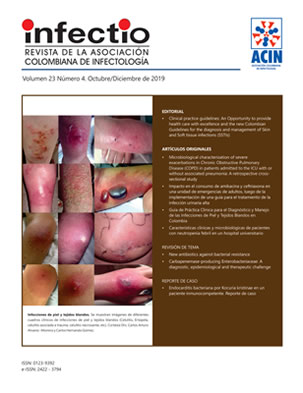Latent tuberculosis infection in patients with autoimmune diseases treated with Infliximab and Etanercept
Contenido principal del artículo
Resumen
Introduction: Latent tuberculosis infection (LTI) in patients receiving biological therapies is a reality, but this has not been studied in depth in Colombia.
Objective: To determine the prevalence of LTI in patients with autoimmune diseases receiving treatment with Infliximab / Etanercept in a referral health center in Cali, Colombia, between the years 2011-2017.
Methodology: A retrospective observational study was conducted. We reviewed the ‘Registry of patients exposed to tumor necrosis factor-alpha (TNF-?) antagonist drugs in Fundación Valle del Lili’. Patients diagnosed with a chronic inflammatory disease were included who received treatment with Infliximab, Etanercept, or both and followed at least two years.
Design: Retrospective observational study. We reviewed the ‘Registry of patients exposed to tumor necrosis factor alpha (TNF-?) antagonist drugs in Fundación Valle del Lili’. Patients diagnosed with a chronic inflammatory disease were included who received treatment with Infliximab, Etanercept or both and followed at least a period of 2 years.
Results: We included 82 patients; the median age was 47.5 years (IQR=28-60 years), 76% were female, 2% had intimate contact with tuberculosis, 15% were older than 65 years. The 56% had a diagnosis of rheumatoid arthritis as an indication of therapy, and 2% presented infection by hepatitis C virus. The median PPD was 12 mm (IQR=10-17 mm). The prevalence was 3.8% for LTI.
Conclusion: The conversion to LTI shows an important prevalence, so it is convenient to perform a routine follow-up of patients receiving therapies with Infliximab and Etanercept.

